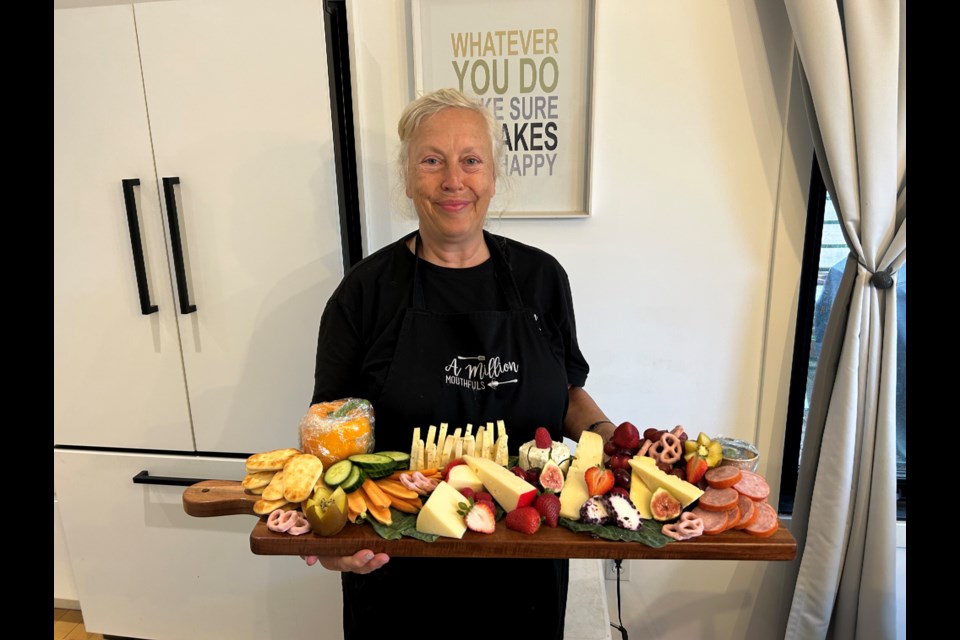Whether you’re celebrating Valentine’s Day with the family, on your own or with your special someone, creating a charcuterie board is a great way to mark the day of love.
Charcuterie boards, where you present a variety of cured meats and cheeses with accompaniments, come from Europe and became a craze in North America, pre-COVID-19, said Anne-Marie Million, chef and owner of A Million Mouthfuls Catering, which has kitchen space on Mulock Drive in Newmarket.
While some believe the charcuterie board is no longer popular, Million suggests people need only to look at the number of restaurants and grocery stores that still provide it on the menu. The charcuterie board is evolving, however, with people offering new ideas including the butter board — butter smeared on a platter with pieces of bread that can be used to scoop it up.
“I hope it doesn’t take off.”
A charcuterie board is “a conversation piece, part of an evening on entertainment.”
And it’s one people can create at home.
To start, you need a board and, for most, that board is made out of wood and can be any shape and size. While you could get a heart-shaped charcuterie board for Valentine’s Day, Million suggested the board should be regular shaped and the accompaniments, the foods added to the board, can be shaped into the symbol of love.
Once the board is chosen, people can then start adding their meats and cheeses — between three and five types of each depending on how many people served.
For cheese, “there should be a mixture of domestic and imported and there should be hard, soft and semi-soft,” Million said. “An aged cheddar, a soft brie and a semi-soft gouda. And stay away from things like blue; it overpowers” and people rarely eat it. Warm brie with either a sweet or savoury topping works well for Valentine’s Day, Million said.
And don’t put the whole block of cheese out. Instead, cut off some pieces and fan it out or crumble some cheese so people will be encouraged to eat the cheese rather than be afraid to cut into it. Don’t forget the tools — cheese knives, spoons, and forks.
For meats, German salami works well. That firmer type of meat also works best for shaping it into roses because, for Million, a great charcuterie board should be beautiful to look at.
In addition to “good cheeses and meat,” there should also be accompaniments — quality mustards, nuts, jellies such as red pepper or a mango chutney, fruit such as figs and grapes, “and good olives — you have to have those.” For Valentine’s Day, there should be chocolate — chocolate-dipped strawberries or chocolate-covered blueberries, for example.
The accompaniments should be placed in vessels — unique ceramic bowls and dishes, which “makes the food nice and contrasting.” Million would avoid using wood dishes as wood on wood doesn’t work. She also loves using food as serving vessels: carved-out peppers to serve hummus, collard greens and Swiss chard to display cheeses, which makes “the whole thing basically edible.” People can cut fruit into heart shapes for Valentine’s Day. “You can cut kiwi into crowns and place them (on the board), adding a lot of visual interest.” Her favourite thing is flowers, food-grade flowers such as pansies that add a dash of colour to the charcuterie board.
“You want to make it look pretty and interesting.”
The size of your board and what you provide on it depends on whether the charcuterie board is the meal, to be enjoyed over conversation, or as an appetizer.
Regardless, you should provide little plates so people can choose what appeals to them and move on, rather than hover over the board.
A charcuterie board “is a tasting experience,” Million said.
While a charcuterie board is, by definition, meats and cheeses, people often make a sweet charcuterie board.
King City’s Suzie Durigon, author of the Just Crumbs blog and Baked cookbook, offers several ideas for a sweet charcuterie board, including chocolate bark, chocolate bites, raspberry heart meringue sandwiches and sweet Valentine’s muddy buddies. She also suggested using Pilsbury dough, which can be cut into heart shapes and then baked to be used as crackers for your regular charcuterie board.



